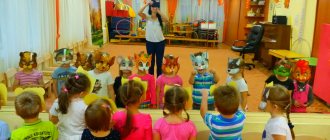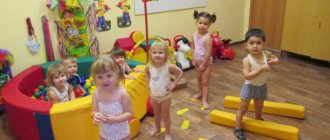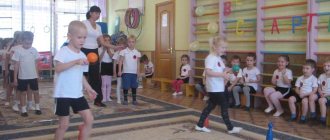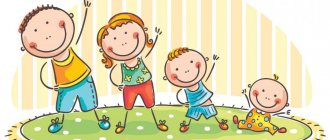Self-analysis of morning exercises in the middle group of preschool educational institutions
Self-analysis of morning exercises
"Journey to the Winter Forest"
(middle group)
This complex of morning exercises is current in the long-term planning for the month. The complex is interconnected with other complexes on the theme: “Winter”, “Winter fun” and is based on the children’s experience in performing motor skills. This complex contributes to the development of children’s physical qualities; strengthening motor skills.
When preparing for morning exercises, the age characteristics of children in the middle group were taken into account: unstable excitability of children, high mobility, emotional instability.
To carry out organized activities, the following was provided:
– the day before, the children were warned about the presence of guests;
– wet cleaning and ventilation of the room for morning exercises was carried out;
– the outline of the morning exercises was learned and prepared by the teacher (I did not resort to the help of the outline during the implementation);
– the exercises were performed to the sound of a tambourine (if required);
– the duration of morning exercises was 6-8 minutes.
So, the goal of morning exercises is to strengthen the motor skills of children, therefore, based on the goal, the tasks of morning exercises were as follows:
1) exercise children in walking and running in various ways;
2) develop the ability to act on a signal from the teacher;
3) teach children to perform exercises in accordance with the spoken words of the text, because the complex of morning exercises was united by a single plot;
4) make children want to participate in morning exercises.
The form of organization of children is frontal (all together). The structure of morning exercises consisted of 3 parts.
In the introductory part, where the children practiced walking in various ways and acted on the teacher’s signal. While walking, the children’s posture, the distance between children, and the quality of exercises were monitored. The introductory part ended with formation in a circle (at the teacher’s signal, when they entered the forest clearing)
In the second part - general developmental exercises - 5 general developmental exercises were used. Each exercise was repeated 5-6 times. This dosage corresponds to the age of children of the middle group. General developmental exercises were also united by a common theme, where proper breathing, IP, synchronicity and quality of exercises were monitored. In this complex, the exercises were given in the following sequence.
– for the muscles of the shoulder girdle and arms;
– for the muscles of the lumbar region;
- for legs.
This sequence is provided for by the methodology for conducting morning exercises, the “Childhood” program, and in accordance with the age of the children.
To reduce the general arousal of the body, the final part included one type of walking, running at a moderate pace, and regular walking one after another with an exercise to restore breathing.
After completing these exercises, the children again found themselves in a fairy-tale forest clearing, where a surprise moment awaited them - a low-mobility game with the word “Winter-winter”, where the main character is the Snowman (Teacher).
This game was not previously familiar to children and was played for the first time. The hero's movements were constructed in accordance with the text. The snowman and the children performed the movements simultaneously, repeating the words of the text. The game was played 2-3 times. The snowman used imitative movements. Imitative exercises interested the children, helped them cope better with the task, and their playful form made the children want to repeat these movements. The teacher’s speech was clear, expressive, and emotionally charged.
Throughout the morning exercises, the teacher performed all the exercises with the children from beginning to end. Methods such as: explanations and instructions were used during the exercises. I also used praise and an example from another child.
I was satisfied with the morning exercises; the children did it with desire and pleasure. By playing, I managed to evoke an emotional response to “Journey into the Winter Forest.” I consider the previously set goals and objectives achieved.
Complex 1
- Forming in a line, checking posture.
- Walking one after another in a column one at a time.
- Walking on toes, hands on the belt.
- Walking with legs raised high.
- Run at a slow pace in a column one at a time.
- Running scattered and in a column.
- I.p. - basic stance, hands on the belt.
- 1 – arms to the sides;
- 2 – arms up and rise on your toes, reaching for your hands;
- 3 – arms to the sides;
- 4 – i.p.
- I.p. - Spread your feet shoulder-width apart, arms to the sides.
- 1 – bend over with a turn so that your right hand touches the toes of your left foot.
- 2 – i.p.;
- 3 – similar tilt in the other direction;
- 4 – i.p.
- I.p. - basic stance, hands on the belt.
- 1 – bring your arms forward, sit down (keep your back straight);
- 2 – i.p.;
- 3 – 4 – similar.
- I.p. - basic stance, arms down.
- 1 – raise your arms up, put your right leg back on your toes, bend over;
- 2 – i.p.;
- 3 – move your left leg in the same way;
- 4 – i.p.
- Jumping alternately on one leg.
- Jumping on both legs.
- Walking in place.
- Breathing exercise “Inhale (stretch, raise your arms up to your sides) - exhale (bend over, lower your arms).
A set of exercises with a ball
- Forming in a line, checking posture.
- Walking while stepping over balls.
- Running like a snake past the balls.
- I.p. - feet shoulder-width apart, ball in hands.
- 1 – throw the ball, look up at it;
- 2 – catch the ball, lower your head;
- 3 – 4 – similar.
- I.p. - feet shoulder-width apart, hold the ball with straight arms in front of your chest.
- 1 – turn to the right (do not lower your arms);
- 2 – turn left;
- 3 – 4 – similar.
- I.p. - basic stance, ball in right hand.
- 1 – raise both arms up from the sides and transfer the ball to the left hand;
- 2 – lower your hands;
- 3 – 4 – similar.
- I.p. - basic stance, ball in hands, arms down.
- 1 – sit down with your arms extended with the ball in front of you;
- 2 – i.p.;
- 3 – 4 – similar.
- Walk on your toes, hold the ball with straight arms above your head.
- Jumping while holding the ball with your feet.
- Easy running.
- Exercises to restore breathing.
Complex 3
- Forming in a line, checking posture.
- Walking on toes.
- Walking on your heels.
- Running like a snake.
- I.p. - basic stance, hands on waist.
- 1 – tilt your head forward, touch your chin to your chest;
- 2 – throw your head back;
- 3 – 4 – similar.
- I.p. - legs slightly apart, hands down.
- 1 – raise your arms up through your sides and clap;
- 2 – i.p.;
- 3 – 4 – similar.
- I.p. - basic stance, hands on the belt.
- 1 – raise your arms up, bend over;
- 2 – bend down and touch your toes;
- 3 – sit down, put your arms forward;
- 4 – i.p.
- I.p. - basic stance, hands on the belt.
- 1 – lunge to the right side, arms to the sides;
- 2 – i.p.;
- 3 – similarly to the left;
- 4 – i.p.
- Walking on toes, hands behind head.
- Walking in a squat, hands on the belt.
- Frog jumps.
- Running with hops.
- Breathing exercise “Clock”.
Methods for doing exercises in kindergarten
Carrying out an educational session is a responsible process, since the work involves children. Exercises for children in preschool educational institutions should be performed either by a physical instructor in the gym, or directly by a teacher directly in the group. According to the rules, UG is carried out half an hour before the first meal.
Hoop exercise
Duration recommendations
UG in each kindergarten group differs not only in duration, but also in the nature of certain exercises. Recommendations:
- The duration of the lesson in the younger group of kindergarten should not be more than 5 minutes. To make it interesting for students, exercises should take place in the form of a game with jokes and jokes. For example, kids can be asked to walk like a bear, a fox or a horse. Hula hoops, cubes and maracas are suitable for performing exercises.
- In the middle kindergarten group, the training course lasts 6 minutes. The structure of the exercise is a little more complicated than the previous one; you can add ribbons and balls as objects for exercise.
- Pupils in the senior group of kindergarten have excellent memory, so the GC can be carried out without the participation of a teacher. The teacher only has to show them how to practice once. Recommended equipment includes pigtail cords, balls, hoops and sticks. The complex can include dancing and rhythm. Lesson duration is approximately 10 minutes.
- The training session in the preparatory group of the kindergarten lasts 12 minutes and, by and large, repeats the complex of the senior group. The equipment used is jumping ropes and dumbbells. In addition, some sports elements using a wall bars can be added to the complex.
How to organize children for morning exercises
In addition to the game theme, the teacher can use other techniques to attract children to the UG. Expressive language, engaging content and positivity will help motivate students. You can play it so that they want to exercise on their own, become healthier and stronger.
An original approach will help motivate you to do morning exercises at a preschool educational institution. For example, a teacher can invite all the children to visit Winnie the Pooh, and to get there, you need to jump three times and smile. This element of the game will attract the children, and they will definitely fulfill all the conditions.
At preschool age, all children are very inquisitive. They are interested in how animals move, flowers grow and what is happening on the planet. Experienced teachers use this to organize effective exercises. They come up with a lot of playful exercises for children to exercise in the morning with the connection of characters and fictional characters.
Swimming lessons for a child over 3 years old in the pool, the importance of lessons
Important! If a child has a certificate stating that physical activity is temporarily contraindicated for him (these are issued after an illness), you can offer him to be the presenter or observe the process from the bench.
A set of exercises with a gymnastic stick
- Forming in a column, checking posture.
- Walking while crawling under a stick.
- Running around the perimeter of the hall, bending around sticks placed in its corners.
- I.p. - basic stance, arms down and holding a stick.
- 1 – raise your arms with a stick up above your head and bend over, put your right leg back;
- 2 – i.p.;
- 3 – move your left leg in the same way;
- 4 – i.p.
- I.p. - legs are shoulder-width apart, arms are straight raised above the head and holding a stick.
- 1 – tilt to the right;
- 2 – i.p.;
- 3 – tilt to the left;
- 4 – i.p.
- I.p. - sit on the floor, legs straight, arms in front of you, holding a stick.
- 1 – stretch forward as much as possible;
- 2 – i.p.;
- 3 – 4 – similar.
- I.p. - lie on your back, legs straight, hold the stick in straight hands, behind your head.
- 1 – roll onto your stomach;
- 2 – roll onto your back;
- 3 – 4 – similarly in the other direction.
- Walking while stepping over a stick, which must be held in front of you with both hands.
- Jumping with both feet over a stick lying on the floor (forward - backward).
- Running in a column one at a time.
- Breathing exercise "Mower".
You can perform similar exercises with a jump rope.
Complex 5
- Forming in a column, checking posture.
- Walking with long strides.
- Walking like a duck.
- Running diagonally.
- I.p. - kneel down, hands down.
- 1 – sit on your knees, group yourself (with your forehead touching your knees, stretch your arms forward, put them on the floor);
- 2 – 3 – freeze in this position;
- 4 – i.p.
- I.p. - kneel down, hands down.
- 1 – sit on the floor to the right of your heels;
- 2 – i.p. (you can help yourself with your hands);
- 3 – similarly to the left;
- 4 – i.p.
- I.p. - lie on the carpet, legs straight, arms along the body.
- 1 – raise your right leg and both arms up;
- 2 – i.p.;
- 3 – raise your left leg and both arms up;
- 4 – i.p.
- I.p. - lie on the carpet, legs straight, arms along the body.
- 1 – 3 – raise your bent legs and do a “bicycle” movement;
- 4 – i.p.
- Walking in a circle holding hands.
- Jumping - legs together, legs apart.
- Run backwards.
- Breathing exercise "Locomotive".
Features of charging older preschoolers
Older preschoolers already understand the main purpose of exercise, so the teacher’s main attention is paid to the correct execution of exercises and breathing, strict adherence to the rhythm and tempo of the complex, a variety of movements, and careful work with objects.
The introductory part is accompanied by several types of walking and lane changes. Discipline is maintained and the columns are even. Leaders are appointed who must turn from a certain place and lead the children of their team to the construction site. Many children strive to earn the right to be a leader, so they try to perform the exercises well. The teacher sometimes entrusts showing the exercise to the children. At this time, the teacher has the opportunity to walk through the rows, provide individual assistance, correct posture, and check correct breathing.
Systematic performance of morning exercises in the older group develops a habit in children. Children are already more independent.
Complex 2
- Forming in a line, checking posture.
- Walking in a column one at a time with alternate turns in different directions at a signal.
- Variable running with acceleration.
- I.p. – basic stance, hands on the belt.
- 1 – tilt of the head to the right shoulder;
- 2 – i.p.;
- 3 – tilt of the head to the left shoulder;
- 4 – i.p.
- I.p. - basic stance, arms in front of the chest, elbows bent.
- 1 – 3 – jerks with bent arms to the sides.
- 4 – jerk with straight arms to the sides.
- I.p. – feet shoulder-width apart, hands on the belt.
- 1 – turn to the right;
- 2 – i.p.;
- 3 – turn to the left;
- 4 – i.p.
- I.p. – basic stance, hands on the belt.
- 1 – lunge with your right foot;
- 2 – i.p.;
- 3 – lunge with the left leg;
- 4 – i.p.
- Alternate jumps - legs together, legs apart.
- Easy jogging in place.
- Breathing exercise “Balls”.
Complex 4
- Formation in two columns, checking posture.
- Walking in pairs.
- Jumping on both legs, in pairs, holding hands.
- Running in pairs.
- I.p. - sit on the carpet, legs bent at the knees, hands at the back.
- 1 – 4 – circular turn of the head to the right;
- 1 – 4 – circular turn of the head to the left.
- I.p. - sit on the carpet, legs straight, arms down.
- 1 – lean forward, trying to touch your toes with your hands;
- 2 – i.p.;
- 3 – 4 – similar.
- I.p. - sit on the carpet, legs bent at the knees, hands at the back.
- 1 – raise your right leg, pull your toe up;
- 2 – i.p.
- 3 – raise your left leg in the same way;
- 4 – i.p.
- I.p. - Lie on your back, straight arms behind your head.
- 1 – roll onto your stomach;
- 2 – i.p.;
- 3 – 4 – similar.
- Walking on the inner (outer) side of the foot.
- Running with straight legs.
- Breathing exercise “Trumpeter”.
Complex 6
- Forming in a line, checking posture.
- Walking trail after trail.
- Walking on a gymnastic bench.
- Running in a circle with side steps.
- I.p. - sit on your heels, cross your arms over your chest.
- 1 – rise up, spread your arms to the sides;
- 2 – sit on your heels, cross your arms and hug yourself;
- 3 – 4 – similar.
- I.p. - sit on the carpet, legs straight, arms supported behind you.
- 1 – turning around, move your right hand behind your left, stretch;
- 2 – i.p.;
- 3 – turn in the other direction;
- 4 – i.p.
- I.p. - sit on the carpet, legs straight, arms supported behind you.
- 1 – raise your heels without lifting your toes off the floor;
- 2 – i.p.
- 3 – 4 – similar.
- I.p. - lie on your stomach.
- 1 – clasp your ankles with your hands;
- 2 – 3 – raising your legs and upper body, bend over;
- 4 – i.p.
- Alternate running and walking.
- Alternate jumps on the right and left legs.
- Breathing exercise “Mill”.





